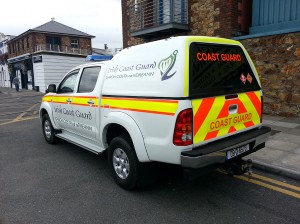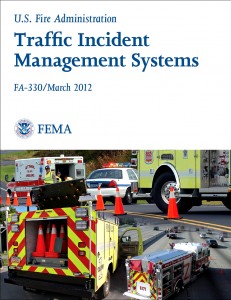2013-09-05: A few days ago, I was travelling on a motorway in Ireland … the scenery was luscious, and daylight and weather conditions were good … when I noticed that the visibility and marking of Emergency Response and Public Service Vehicles varied considerably. The rear of one vehicle, in particular, had highly visible markings … but it was pulling a high trailer, without any markings … and, of course, the vehicle itself and its bright luminescent markings were almost obscured.
What would happen at night, in heavy rain … if any of these vehicles had to stop on a road without any public lighting … as they responded to a traffic accident … or because they were part of a Garda/police checkpoint ? Serious danger for the responders and other road users is the obvious answer !
Then, more recently, while walking around Howth Harbour, in Dublin … I spotted this Irish Coast Guard Vehicle … which made me feel more optimistic …

.
Click the Link Above to read and/or download PDF File (4.35 MB)
Produced by the U.S. Cumberland Valley Volunteer Firemen’s Association (CVVFA) Emergency Responder Safety Institute (ERSI) … with the support of the Federal Emergency Management Agency’s United States Fire Administration (USFA), and the National Institute of Justice (NIJ) – the research, development and evaluation agency of the U.S. Department of Justice.
Author: Ron Moore – Chief Instructor, CVVFA Emergency Responder Safety.
CVVFA ERSI WebSite: www.respondersafety.com
.
 U.S. Fire Administration Report FA-330 – March 2012
U.S. Fire Administration Report FA-330 – March 2012
USFA: ‘Traffic Incident Management Systems’ (2012)
Click the Link Above to read and/or download PDF File (4.87 MB)
.
Both of these documents must be carefully adapted by the reader to suit a European context … as the following List of Recommendations from USFA Report FA-330 will clearly indicate …
To help decrease vehicle-related injuries and fatalities of emergency responders if implemented at the appropriate levels:
1. Develop a comprehensive database that tracks accidents involving emergency vehicles and any resulting injuries and/or deaths to both emergency responders and civilians.
2. Limit speeds to a level that is safe for the vehicle being driven and the road conditions on which it is being operated.
3. Adopt a zero-tolerance alcohol (and drugs) policy and enforce an 8-hour time difference between alcohol consumption and the commencement of work.
4. Equip all emergency vehicles with appropriate traffic control and safety equipment.
5. Ensure all traffic-channelizing devices meet applicable standards.
6. Ensure flaggers, if used, are properly trained and meet Manual of Uniform Traffic Control Devices for Streets and Highways (MUTCD) qualifications.
7. Require members to wear highly reflective American National Standards Institute (ANSI)/International Safety Equipment Association (ISEA) 107 Class II, Class III, or ANSI/ISEA 207 compliant public safety vests whenever they operate in a roadway.
8. Mark the emergency vehicle perimeter with retro-reflective striping or markings.
9. Extinguish forward facing emergency vehicle lighting when parked on the roadway, especially on divided roadways.
10. Fire departments should consider the implementation of traffic safety response units.
11. Position the initial-arriving emergency vehicle in a blocking position to oncoming traffic.
12. Establish an adequately sized work zone.
13. Develop a formalized Traffic Incident Management (TIM) information sharing method between public safety and transportation agencies.
14. Manage major traffic incidents using the National Incident Management System (NIMS) Incident Command System (ICS).
15. Consider the use of Unified Command (UC) to manage traffic incidents involving multiple jurisdictions or disciplines.
16. Incorporate transportation departments into ICS when appropriate.
17. Ensure adequate training on roadway hazards and safety procedures for responders.
.
.
END

